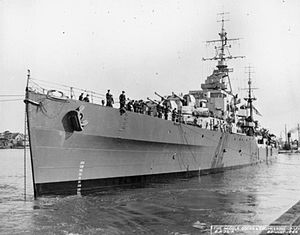HMNZS Black Prince

Black Prince under tow on the River Tyne, July 1944
|
|
| History | |
|---|---|
|
|
|
| Name: | HMS Black Prince |
| Namesake: | Edward, the Black Prince |
| Builder: | Harland & Wolff (Belfast, Northern Ireland) |
| Yard number: | 1049 |
| Laid down: | 1 December 1939 |
| Launched: | 27 August 1942 |
| Completed: | 20 November 1943 |
| Commissioned: | 30 November 1943 |
| Decommissioned: | March 1962 |
| Out of service: | Loaned to the Royal New Zealand Navy, 25 May 1946 |
| Fate: | Sold for scrap in March 1962, arrived at Mitsui & Company, Osaka breakage yards, Japan, on 2 May 1962 for breaking up |
| Notes: | Pennant number 81 |
|
|
|
| Name: | HMNZS Black Prince |
| Commissioned: | 25 May 1946 |
| Out of service: | Returned to Royal Navy control on 1 April 1961 |
| General characteristics | |
| Class and type: | Dido-class light cruiser |
| Displacement: |
|
| Length: | |
| Beam: | 50.5 ft (15.4 m) |
| Draught: | 14 ft (4.3 m) |
| Propulsion: |
|
| Speed: | 32.25 knots (60 km/h; 37 mph) |
| Range: |
|
| Complement: | 530 |
| Armament: |
|
| Armor: |
|
HMS Black Prince was a Dido-class light cruiser of the Royal Navy, of the Bellona subgroup. The cruiser was commissioned in 1943, and served during World War II on the Arctic convoys, during the Normandy landings, and as part of the British Pacific Fleet. In 1946, the cruiser was loaned to the Royal New Zealand Navy, becoming HMNZS Black Prince. The cruiser was docked for modernisation in 1947, but in April, her sailors walked off the ship as part of a series of mutinies in the RNZN. The shortage of manpower resulting from these mutinies meant that the modernisation had to be cancelled, and Black Prince was placed in reserve until 1953. She returned to service after refitting and simplified secondary armament with a single quad pom pom in Q position and 8 x 1, Mk3 40mm electric bofors. The ship was decommissioned again two years later, and she was returned to the Royal Navy in 1961. Black Prince did not re-enter service, and was towed from Auckland to the Osaka breakage yards for scrapping in 1962
She was a modified Dido design, sometimes called Dido Group 2, or the Bellona subgroup with only four 5.25-inch mounts instead of five, and improved anti-aircraft armament. She was built by Harland & Wolff of Belfast, Northern Ireland, with her keel being laid down on 1 December 1939. She was launched on 27 August 1942, and commissioned on 30 November 1943.
Black Prince was named after Prince Edward (1330-1376), the eldest son of King Edward III.
After commissioning, Black Prince served on Arctic convoys and then came south in preparation for the invasion of Europe, being employed on offensive sweeps against German coastal convoy traffic. On the night of 25 and 26 April 1944, accompanied by Canadian destroyers, she was involved in the action which sank the torpedo boat T29 and damaged T24 and T27 off the north Brittany coast.
...
Wikipedia
